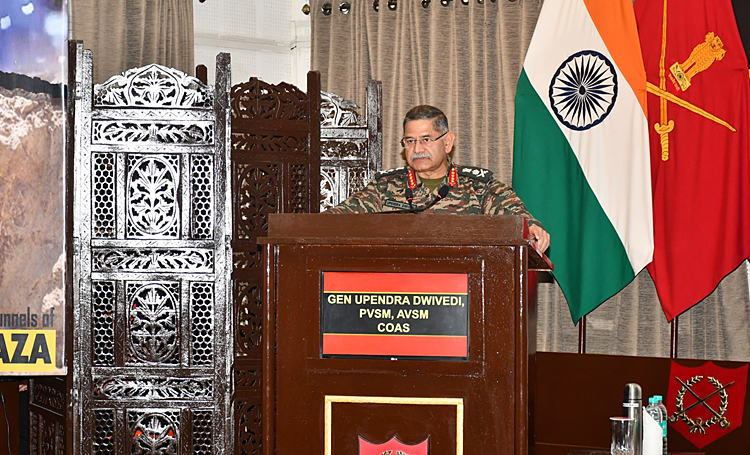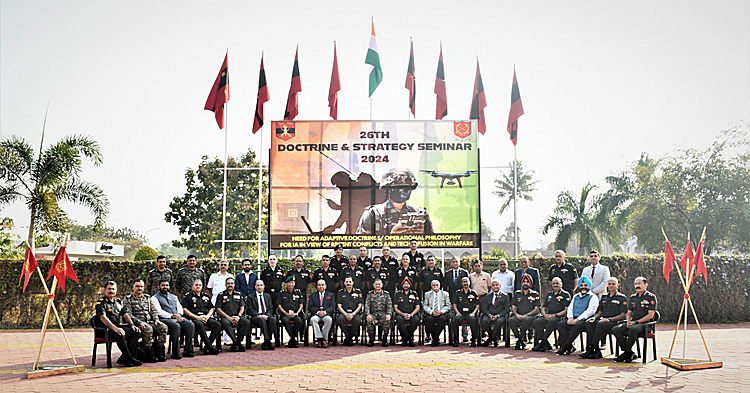INDIAN ARMED FORCES CHIEFS ON OUR RELENTLESS AND FOCUSED PUBLISHING EFFORTS

The insightful articles, inspiring narrations and analytical perspectives presented by the Editorial Team, establish an alluring connect with the reader. My compliments and best wishes to SP Guide Publications.

"Over the past 60 years, the growth of SP Guide Publications has mirrored the rising stature of Indian Navy. Its well-researched and informative magazines on Defence and Aerospace sector have served to shape an educated opinion of our military personnel, policy makers and the public alike. I wish SP's Publication team continued success, fair winds and following seas in all future endeavour!"

Since, its inception in 1964, SP Guide Publications has consistently demonstrated commitment to high-quality journalism in the aerospace and defence sectors, earning a well-deserved reputation as Asia's largest media house in this domain. I wish SP Guide Publications continued success in its pursuit of excellence.
- Indian Air Force Aims for Full Indigenous Inventory by 2047 — Air Chief Marshal A.P. Singh
- General Upendra Dwivedi takes over as the Chief of the Army Staff
- Rajnath Singh assumes charge as Defence Minister for the second consecutive term
- Admiral Dinesh K. Tripathi assumes Command of the Indian Navy as 26th Chief of the Naval Staff
- Prime Minister witnesses 'Bharat Shakti' – a Tri-Services Firing and Manoeuvre Exercise in Pokhran, Rajasthan
Army Chief General Upendra Dwivedi Addresses 26th Doctrine and Strategy Seminar

General Upendra Dwivedi, Chief of the Army Staff (COAS) addressed participants of the 26th Doctrine and Strategy Seminar (DSS) in Mhow today. The two-day seminar, on the theme, 'Need for Adaptive Doctrines/ Operational Philosophy for Indian Army in view of recent Conflicts and Technology Infusion in Warfare', was conducted at the Army War College on November 27 and 28, 2024.
Aim of the seminar was to critically examine the validity of established doctrines, operational strategies, and tactics, techniques and procedures (TTPs) of the Indian Army in light of recent conflicts and induction of niche technology and recommend necessitated changes in doctrines, operational philosophies and TTPs to meet the challenges of future conflicts. Experts from the fields of Geo-Strategic affairs, Geo-Political affairs, Armed Forces, Defence Public Sector Undertakings and Industries expressed their views on various operational and logistics aspects and capability development of Armed Forces in the modern warfare environment.
The seminar was organised under three themes as follows: -
- The Global Scan - Latest Trends and Technology Infusion in Warfare and Imperatives for the Indian Army: The first session focused on global scan to identify latest trends in military niche technology and analyse its impact on conduct of warfare, highlighted the doctrinal and tactical changes adopted by nations in their warfighting approach in recent conflicts and imperatives for Indian Army, analysis of the adversaries' warfighting concepts and their pursuit for niche technology and implications for India, and identification of the technologies being developed/ imported by the adversaries and their intended application against India including in sub conventional operations.
- Warfighting Strategy - Impact on Conduct of Warfare - Rethinking Doctrine/ Strategy/ TTPs: The second session critically analysed the validity of existing doctrines/ strategy/ TTPs in conventional warfighting in mountains/ High Altitude Areas (HAA) with infusion of niche technology, conventional warfighting in plains and deserts along with recommended changes in doctrine/ strategy to meet the opportunities and challenges posed by infusion of niche military technology, and the impact of new age technology on CI/ CT operations and recommend changes in doctrine/ strategy and TTPs.
- Technology as an Enabler – Human Resource (HR) and Logistics Aspects: The last session tried to identify the major impact on HR aspects as a fallout of integrating niche technology into the warfighting doctrines/ strategy and analyse the major impact of niche technology on logistic operations and need for restructuring the current Operational Logistics framework of the Indian Army.
During his talk, the COAS commended the in-depth analysis of strategic and operational issues, emphasising the critical need for transformation and adaptation in response to the evolving nature of warfare. The COAS stated that modern conflicts are increasingly focused on achieving political objectives through non-military means, with military strategies incorporating new technological advancements. He described contemporary warfare as a continuum of 5Cs - Competition, Crisis, Confrontation, Conflict, and Combat, blending statecraft and diplomacy with kinetic and non-kinetic actions.
The COAS highlighted the defining characteristics of 5th generation warfare, including non-kinetic military actions such as disinformation, cyber-attacks, and the use of artificial intelligence and autonomous systems. He stressed that while newer forms of warfare are emerging, older generations remain relevant, with both non-contact and non-kinetic methods being integrated into military strategies.

Drawing lessons from the Russia-Ukraine war, the COAS identified key takeaways: the importance of Combined Arms Operations, leveraging asymmetric tactics, and enhancing Civil-Military Integration. These lessons underscore the need for military leaders to operate seamlessly within the broader DIME T framework. The COAS also pointed to the ongoing Decade of Transformation (2023-2032) as a step toward achieving this integrated approach.
Addressing national security challenges, the COAS discussed the complexities of Grey Zone operations, the two-front challenge, and the need for convergence of land operations, maritime and air strategies to protect India's interests in the Indo-Pacific region. With adversaries increasingly employing hybrid strategies, the Indian Army must adapt doctrines to counter multi-dimensional threats from both state and non-state actors.
The COAS emphasised that military doctrines must be flexible, enabling unity of effort while fostering individual judgment. Technology, including artificial intelligence, precision warfare, and cyber capabilities, must be integrated to support multi-domain operations. He stressed the need for military leaders to adapt quickly to technological challenges at the front lines and to foster institutional agility in developing and deploying new technologies.
On the role of leadership, the COAS highlighted its paramount importance in military adaptation. Strong and adaptive leadership is essential to overcome challenges in doctrine and technology. The COAS also advocated for a reduction in excessive doctrinal rigidity, urging greater agility, decentralisation, and rapid decision-making, particularly at the tactical level.
In conclusion, the COAS called for the development of adaptive doctrines that incorporate dynamic threat assessments, technology integration, realistic training, and wargaming. These doctrines should promote jointness, interoperability with allied nations, and seamless civilian-military synergy, leveraging innovations from the private sector for military applications.





